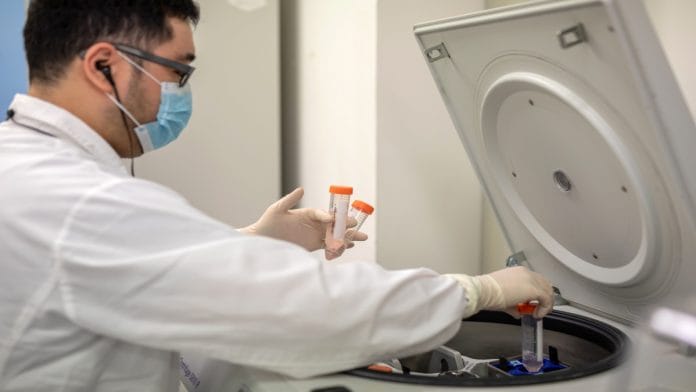The way the Covid-19 crisis ends is with vaccines — not a vaccine. More than one horse can win this race. Some of us might end up getting a shot of a more traditional vaccine, which uses parts of an inactivated virus to stimulate immunity. Others might get vaccines based on emerging technologies that use synthetic versions of the virus’s genetic code.
One such novel candidate, based on RNA and made by Moderna, showed promising results in early human trials, though critics warned the evidence is preliminary. Meanwhile, a different prototype based on DNA made headlines for an experiment that showed it worked in monkeys.
In the end, some vaccines might be extremely effective but harder to scale; others the opposite. Even a less-effective vaccine might work well enough to provide herd immunity in a wider population. Other vaccines might be more appropriate for health care workers, who have to risk exposure on the job, and need protection as soon as possible.
Scientists have created more than 70 vaccine candidates so far. “If we end up with two, three, or four vaccines, that’s good, since we have seven billion people,” says Harvard vaccine researcher Dan Barouch, who led the development of one of the vaccines featured in recent news. His group began working on a vaccine in January, after the virus started spreading in China.
There are good reasons for him and other scientists to be optimistic. “For Covid-19, it’s clear most humans who get infected recover … that alone shows the human immune system can eliminate the virus,” he says. That makes it a much easier target than HIV, which he calls unprecedented in the history of vaccinology for its ability to evade the immune system. And the SARS-Cov2 virus doesn’t have the fast mutation rate that makes flu viruses a moving target.
Art Krieg, a physician and founder of Checkmate Pharmaceuticals, says he’s very optimistic that because the human immune system can successfully battle the virus, so will one or more of the many experimental vaccines.
All vaccines have to provide a danger signal to “prime” the immune system into acting against an invader. In 1995, Krieg reported the discovery one of these danger signals — called CpG DNA — which has been used in several vaccines, including one for hepatitis B, and is in some of the experimental candidates against the virus that causes Covid-19.
Next, the vaccine has to mimic the invader in order to get the immune system to create specific antibodies that target the intended enemy. Vaccine designers using genetic material (DNA or RNA) have to stimulate the immune system enough to generate those antibodies, but not so much that the immune system destroys the vaccine before it can complete its mission.
The biggest driver of recent headlines (and stock market drama) was a vaccine produced by the Massachusetts-based company Moderna, which is based on synthetic genetic material identical to parts of the code carried by the coronavirus. The genetic material is RNA — the single-stranded cousin of DNA. (Other RNA vaccines are being studied by BionTech, Translate Bio, and Curevac.) The RNA tricks human cells into making proteins identical to the “spike” proteins the virus uses to penetrate human cells. And that, in turn, stimulates the immune system to make antibodies that will be ready to block that protein if the real coronavirus invades.
The excitement about Moderna’s vaccine followed the release of data from a trial that involved 45 volunteers, though the company only described results for eight of them. Of the eight, all produced antibodies with the desired “neutralizing” property needed to attack the virus in the future. What happened to the other 37 people? Since this vaccine requires two doses, they probably just didn’t have that data yet, says Krieg.
A similar concept is behind DNA vaccines. The one developed by Harvard’s Barouch made the news for a successful experiment in monkeys. Other DNA vaccines are already in early human trials, including candidates developed by Oxford University, Johnson & Johnson and the Chinese company CanSino Biologics.
These DNA vaccines use synthetic strings of code for making the spike protein carried by the virus. In some of these, the synthetic DNA is injected alone, while in others, it rides into human cells inside a deactivated cold virus (called an adenovirus). The human cells transcribe the DNA to RNA, and then into the decoy spike protein used to create immunity to the real thing. While the prototype developed by Barouch’s group at Harvard can be given in two shots, the Oxford DNA vaccine and several others that use cold viruses confer immunity with just one shot, says Krieg.
DNA and RNA aren’t our only options. Yet another vaccine concept, made by Dynavax, uses the spike protein itself and stimulates the immune system using a synthetic DNA danger signal — the CpG DNA. These protein-based vaccines would have to be produced in bulk in fermentation vats, which Krieg says is something the biotech industry is equipped to do.
Krieg says all the novel vaccines work through the same well-established scientific principles, and are very likely to be safe. Still, he says, it’s well known that vaccines don’t work as well in the elderly and immunocompromised. Imperfect vaccines could still eradicate the virus through herd immunity but only if the bulk of the population gets vaccinated. Once the technical hurdles are overcome, there will be social hurdles — already, there are movements among anti-vaxxers to resist — but it’s not too soon to plan to surmount them.
Barouch says the ordinarily competitive nature of science has changed, as everyone understands how much is at stake in terms of lives and economic damage. In retrospect, critics might be able to criticize approaches that didn’t work, but right now, we need all the ideas we can get. –Bloomberg
Also read: US pharma giant Merck hopes to beat coronavirus with a pill and two vaccines






